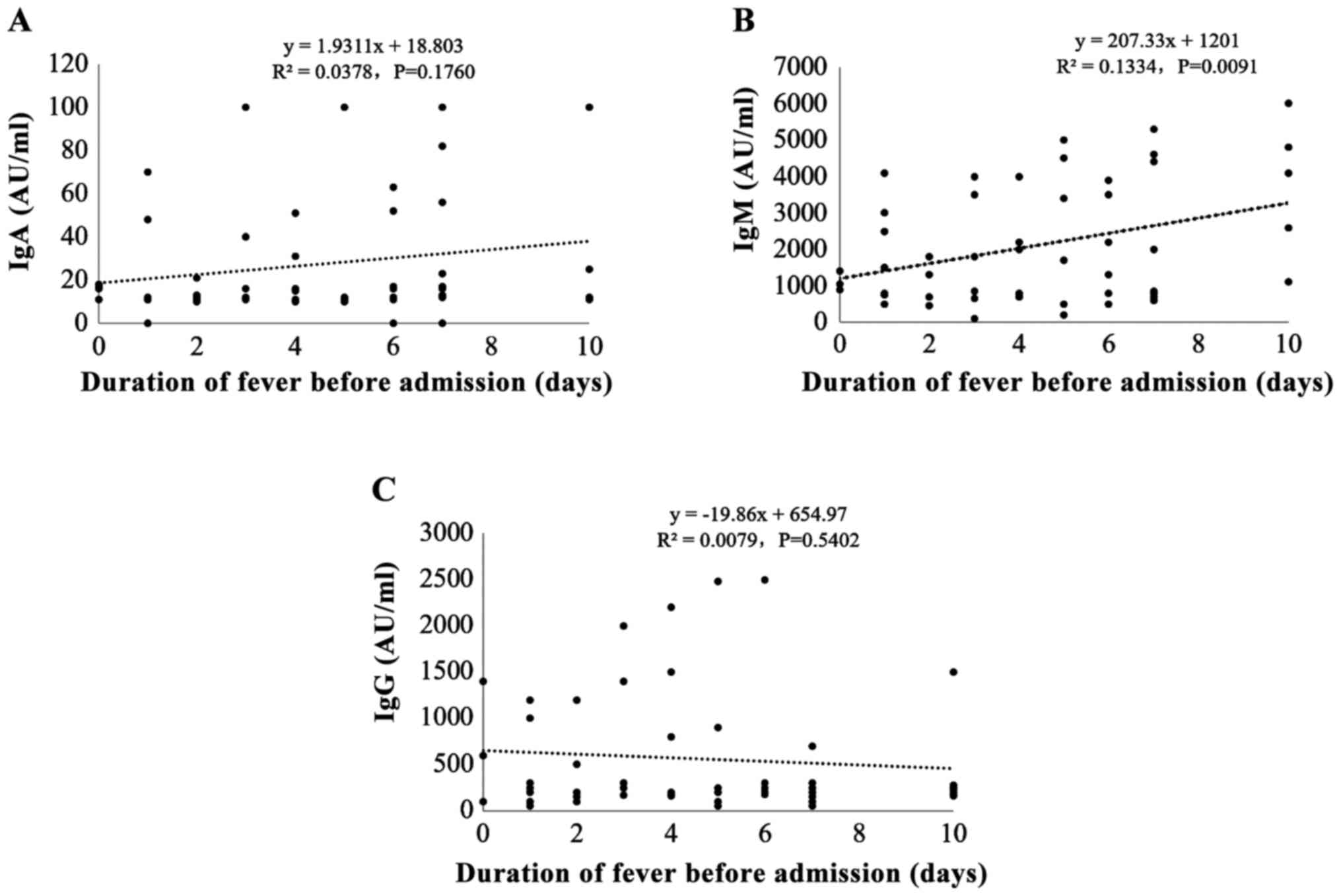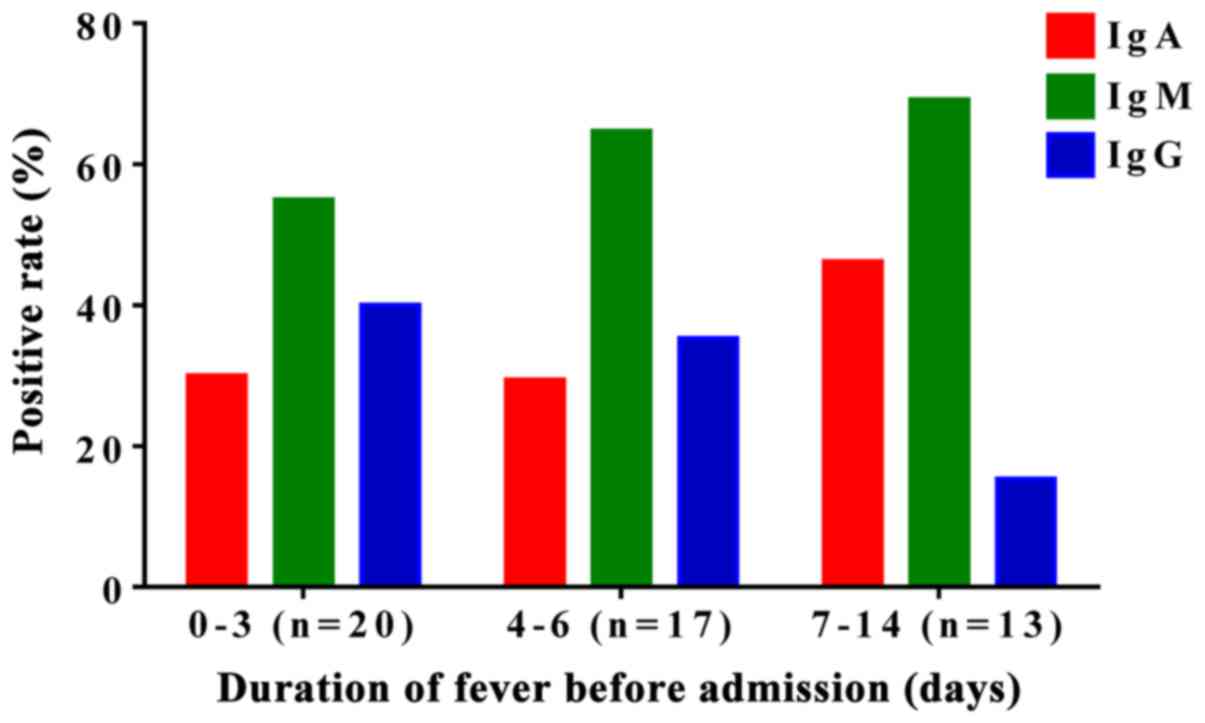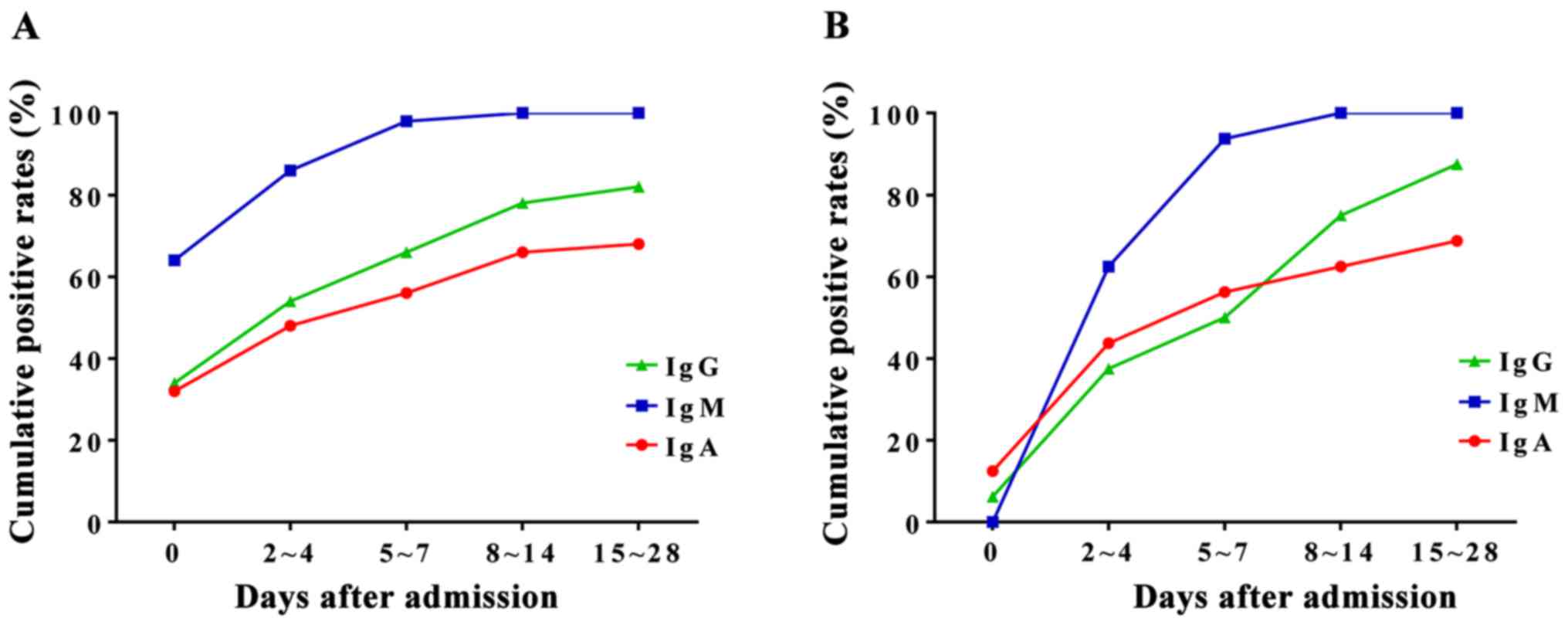Value of serum Mycoplasma pneumoniae immunoglobulin in the diagnosis of mycoplasma-related pneumonia in newborns
Retraction in: /10.3892/etm.2018.6251
- Authors:
- Published online on: June 23, 2017 https://doi.org/10.3892/etm.2017.4654
- Pages: 1445-1449
-
Copyright: © Dong et al. This is an open access article distributed under the terms of Creative Commons Attribution License.
Abstract
Introduction
Mycoplasma pneumoniae (M. pneumoniae) is one of the most common pathogens causing pneumonia, especially neonatal pneumonia. The typical clinical manifestation is cough without runny nose, but the symptoms vary widely from asymptomatic respiratory infections to severe pulmonary infections (1). M. pneumoniae is sensitive to macrolide or tetracycline antibiotics, but because of the lack of appropriate diagnostic methods, these antibiotics are not used in a timely manner. M. pneumoniae is also sensitive to fluoroquinolone antibiotics, but fluoroquinolones cannot be used in neonates because of cytotoxic side effects (2). In recent years, the extensive use of macrolide antibiotics has led to the increase of macrolide-resistant M. pneumoniae around the world (3). The proportion of macrolide-resistant M. pneumoniae in Asia is 10–20% (4,5), whereas in some parts of China it is as high as 90%. Therefore, there is an urgent need for a rapid and accurate diagnosis method of M. pneumoniae infection to choose appropriate antibiotics to treat M. pneumoniae-associated pneumonia, thereby reducing the abuse of antibiotics and drug-resistant strains.
Anti-M. pneumoniae immunoglobulin M (IgM) is used to detect acute infection. However, the levels of IgM antibody in blood were too low to be detected in some patients in the early stage of acute infection and in reinfection (6). In addition, the IgM antibody can only be detected several months after infection in the blood of some patients (7). So, the clinical diagnosis of M. pneumoniae infection is very difficult. In the last few decades, only a small number of studies have reported the use of M. pneumoniae IgA antibodies to diagnose M. pneumoniae infection. Reports indicate that detection of anti M. pneumoniae IgA antibodies in adults is more sensitive than IgM in the diagnosis of acute mycoplasma-associated pneumonia (8). However, the sensitivity of M. pneumoniae IgA was low for diagnosing of mycoplasma-associated pneumonia in neonates (9).
The incidence of M. pneumoniae-associated pneumonia is high in neonates, but no studies have reported the clinical value of anti-M. pneumoniae Ig in the diagnosis of M. pneumoniae-associated pneumonia in neonates. The purpose of this study was to assess the clinical significance and efficacy of anti-M. pneumoniae Ig in the diagnosis of M. pneumoniae in neonates.
Patients and methods
Study subjects
We recruited 80 newborns in Shanghai Ninth People's Hospital, Shanghai JiaoTong University School of Medicine from May 2013 to June 2016. The cohort included 31 boys and 49 girls. Mean age: 16.6±5.3 months, age ranged from 8–27 days. All newborns had cough and fever. Bronchial pneumonia or lobar pneumonia was identified in all newborns by chest X-ray. Body temperature was measured with an infrared tympanic thermometer and temperature above 38.0°C was considered as fever. The patients had continued fever (≥38°C) for 4.3±2.7 days before admission (information provided by the relatives of the patients). All patients with M. pneumoniae infection showed serum antibody positive or increased antibody potency at least two weeks after the infection: 26 were serum positive, in 72 IgM potency increased 2-fold, and in 31 IgG potency increased 4-fold. The patients involved in this study had no other disease that could alter the clinical disease process. The clinical data of the patients included age, fever duration, length of hospitalization, laboratory examination, liver zymogram and CRP test results (Table I). This study was approved by the Ethics Committee of Shanghai Ninth People's Hospital. Signed written informed consents were obtained from the patients and/or guardians before the study.
Methods
All children received macrolide antibiotics and the clinical symptoms improved after treatment. The levels of anti-M. pneumoniae IgA, IgM, and IgG in serum were measured at different time points at early stages, during the development of pneumonia, and after pneumonia. The levels of anti-M. pneumoniae IgM and IgG in serum were measured by ELISA (Ben-Bio, San Diego, CA, USA). The levels of anti-M. pneumoniae IgA in serum were measured with the CHORUS kit according to the manufacturers instructions (Diesse Diagnostica Senese, Siena, Italy). The positive cutoff values for anti-M. pneumoniae IgA, IgM and IgG were 18 AU/ml (the upper and lower limits were 10 and 100 AU/ml, respectively), 950 and 320 AU/ml, respectively.
Continuous variables are expressed as mean ± standard error of the mean (mean ± SEM). The initial positive rate of IgA and IgM in M. pneumoniae was analyzed by chi-square test. M. pneumoniae IgM potency, clinical features, blood laboratory test results, and the correlation with CPR were analyzed using Pearson's correlation analysis and multivariate logistic regression analysis. All experimental data were analyzed with SPSS 13.0. P<0.05 was considered to be statistically significant.
Results
M. pneumoniae IgM potency and pre-hospital fever duration
To investigate the correlation between M. pneumoniae IgM potency and pre-hospital fever duration, we divided the patients into three groups according to the duration of fever before admission: ⅰ) 0–3 days, ⅱ) 4–6 days, and ⅲ) 7–10 days. Most children (40%; 32/80) had <3 days of fever before admission; 27 patients (33.8%) had 4–6 days of pre-hospital fever; and 21 patients (26.3%) had 7–10days of pre-hospital fever. The results showed that the potency of M. pneumoniae IgM, but not IgA or IgG, was positively correlated with pre-hospital fever duration (r=0.377, P=0.002) (Fig. 1).
M. pneumoniae patients show a higher positive rate for IgM
The positive rates for anti-M. pneumoniae IgA, IgM, and IgG were 33.8 (27/80), 63.8 (51/80) and 32.5% (26/80), respectively, in the 80 newborns before admission. IgA and IgM showed relatively higher positive rate. In addition, the positive rates of M. pneumoniae IgM were higher than those of M. pneumoniae IgA in all groups (Fig. 2), indicating that anti-M. pneumoniae IgM had a higher positive rate than that of anti-M. pneumoniae IgA in the diagnosis of neonatal mycoplasma-associated pneumonia.
Two sera test of the patients with clinical symptoms and M. pneumoniae IgM negative
To compare the cumulative positive rates of M. pneumoniae IgA, IgM, and IgG, we compared the values within 14 days after admission. We collected blood samples at different time points before and after admission. The samples were divided into 5 groups according to the time of sampling: ⅰ) the day of admission, ⅱ) 2–4 days after admission, ⅲ) 5–7 days after admission, ⅳ) 8–10 days after admission, and ⅴ) 11–14 days after admission. The initial positive rate of M. pneumoniae IgM was 63.8% (51/80) (Fig. 3A). The cumulative positive rates of M. pneumoniae IgM in groups 2 and 3 were 85.0 and 97.5%, respectively (Fig. 3A). Serum M. pneumoniae IgM for 26 cases (32.5%) turned positive one week after admission. These results suggest that it is necessary to collect double serum for patients with clinical symptoms, but initially negative for anti-M. pneumoniae IgM. In addition, the results also showed that the cumulative positive rate of serum M. pneumoniae IgM was higher than that of IgA.
Of the 80 children, 26 (32.5%) cases had serum M. pneumoniae IgM negative at admission and turned positive two weeks after admission. Of these 26 patients, 4 (15.4%) had initial serum M. pneumoniae IgA positive. However, the positive rate of serum M. pneumoniae IgM was higher than that of IgA in all patients 2–4 days after admission (61.5 vs. 46.2%) (Fig. 3B), indicating the importance of two sera tests in the clinical diagnosis.
Discussion
The course of mycoplasma infection is often relatively long. In adults, M. pneumoniae can still exist one week after medical treatment (8). Our results showed that most newborns with mycoplasma-associated pneumonia were admitted to the hospital within one week (4.3±2.7 days) after M. pneumoniae infection. The possible explanation is that fever is the main clinical symptoms in children, but persistent cough is the typical symptom in adults. Compared with adults, newborns with infection can be admitted earlier to hospital. Our results showed that many children (21/80, 26.3%) were negative for M. pneumoniae-specific antibodies at admission. To avoid false negatives, two serum samples were used to test M. pneumoniae IgA, IgM and IgG after admission.
Previous studies reported that serum anti-M. pneumoniae IgA is a good indicator for the detection of M. pneumoniae infection in adults (10–12). Detection of serum M. pneumoniae IgA in adults is more sensitive for the diagnosis of M. pneumoniae infection than detection of IgM (8). However, this conclusion is inconsistent with the results reported by Yamazaki et al (9) who found that serum M. pneumoniae IgA was a poor indicator of M. pneumoniae infection. Here, we examined the efficacy of M. pneumoniae IgA in the diagnosis of neonatal mycoplasma-associated pneumonia. The positive rates of serum M. pneumoniae IgM and IgA were 63.8 and 33.8%, respectively, on the day of admission. These rates were positively correlated with the duration of fever before admission. We also found that the positive rate of serum M. pneumoniae IgM was higher than that of IgA in all the groups classified by pre-hospitalization fever duration, suggesting that detection of serum M. pneumoniae IgA is less sensitive than IgM in the diagnosis of neonatal mycoplasma-associated pneumonia. This may be explained by the immature immune system of newborns.
In our study, the positive rate of M. pneumoniae IgM was 63.8% in patients with an average duration of 4.3±2.7 days before admission. This result is consistent with a previous report (13). That is, the positive rate of M. pneumoniae IgM was 62.2% in the first week after mycoplasma infection and ranged from 70.9 to 81.8% in the second week after infection (14,15). The sensitivity of serological testing is limited by the specimen, the standard diagnostic method and the method of detection. This may be used to explain the high sensitivity of M. pneumoniae IgM in patients with longer hospitalization. We found that the positive rate of M. pneumoniae IgA was positively correlated with the pre-hospitalization fever duration, although this correlation was lower than the correlation between IgM and pre-hospitalization fever duration.
The 4-fold increase of M. pneumoniae IgG in the acute phase and the reversion of the disease is considered the gold standard for diagnosis of M. pneumoniae respiratory tract infection (16). Medjo et al (14) reported that 90% of the patients with 4-fold increase of M. pneumoniae IgG antibody potency in two sera also showed throat swab M. pneumoniae positive in PCR detection. While Ma et al (15) reported that only 2.4% of the patients with a four-fold increase of M. pneumoniae IgG antibody potency in two sera also showed throat swab M. pneumoniae positive. However, 38.8% of patients in this study had a 4-fold increase in M. pneumoniae IgG antibody potency in two sera. Thus, anti-M. pneumoniae IgG cannot provide a timely diagnosis of M. pneumoniae infection. Given the complications of obtaining two sera from newborns, M. pneumoniae IgG is not the best indicator to diagnose M. pneumoniae infection.
In conclusion, detection of M. pneumoniae IgM has higher sensitivity in the diagnosis of neonatal mycoplasma-associated pneumonia than that of the detection of M. pneumoniae IgA. Two sera detection can more effectively improve the diagnostic accuracy.
References
|
Ali NJ, Sillis M, Andrews BE, Jenkins PF and Harrison BD: The clinical spectrum and diagnosis of Mycoplasma pneumoniae infection. Q J Med. 58:241–251. 1986.PubMed/NCBI | |
|
Bradley JS and Jackson MA: Committee on Infectious Diseases; American Academy of Pediatrics: The use of systemic and topical fluoroquinolones. Pediatrics. 128:e1034–e1045. 2011. View Article : Google Scholar : PubMed/NCBI | |
|
Pereyre S, Goret J and Bébéar C: Mycoplasma pneumoniae: Current knowledge on macrolide resistance and treatment. Front Microbiol. 7:9742016. View Article : Google Scholar : PubMed/NCBI | |
|
Wu PS, Chang LY, Lin HC, Chi H, Hsieh YC, Huang YC, Liu CC, Huang YC and Huang LM: Epidemiology and clinical manifestations of children with macrolide-resistant Mycoplasma pneumoniae pneumonia in Taiwan. Pediatr Pulmonol. 48:904–911. 2013. View Article : Google Scholar : PubMed/NCBI | |
|
Wu HM, Wong KS, Huang YC, Lai SH, Tsao KC, Lin YJ and Lin TY: Macrolide-resistant Mycoplasma pneumoniae in children in Taiwan. J Infect Chemother. 19:782–786. 2013. View Article : Google Scholar : PubMed/NCBI | |
|
Sillis M: The limitations of IgM assays in the serological diagnosis of Mycoplasma pneumoniae infections. J Med Microbiol. 33:253–258. 1990. View Article : Google Scholar : PubMed/NCBI | |
|
Thacker WL and Talkington DF: Analysis of complement fixation and commercial enzyme immunoassays for detection of antibodies to Mycoplasma pneumoniae in human serum. Clin Diagn Lab Immunol. 7:778–780. 2000.PubMed/NCBI | |
|
Granström M, Holme T, Sjögren AM, Ortqvist A and Kalin M: The role of IgA determination by ELISA in the early serodiagnosis of Mycoplasma pneumoniae infection, in relation to IgG and mu-capture IgM methods. J Med Microbiol. 40:288–292. 1994. View Article : Google Scholar : PubMed/NCBI | |
|
Yamazaki T, Narita M, Sasaki N, Kenri T, Arakawa Y and Sasaki T: Comparison of PCR for sputum samples obtained by induced cough and serological tests for diagnosis of Mycoplasma pneumoniae infection in children. Clin Vaccine Immunol. 13:708–710. 2006. View Article : Google Scholar : PubMed/NCBI | |
|
Lieberman D, Lieberman D, Ben-Yaakov M, Shmarkov O, Gelfer Y, Varshavsky R, Ohana B, Lazarovich Z and Boldur I: Serological evidence of Mycoplasma pneumoniae infection in acute exacerbation of COPD. Diagn Microbiol Infect Dis. 44:1–6. 2002. View Article : Google Scholar : PubMed/NCBI | |
|
Lieberman D, Lieberman D, Korsonsky I, Ben-Yaakov M, Lazarovich Z, Friedman MG, Dvoskin B, Leinonen M, Ohana B and Boldur I: A comparative study of the etiology of adult upper and lower respiratory tract infections in the community. Diagn Microbiol Infect Dis. 42:21–28. 2002. View Article : Google Scholar : PubMed/NCBI | |
|
Watkins-Riedel T, Stanek G and Daxboeck F: Comparison of SeroMP IgA with four other commercial assays for serodiagnosis of Mycoplasma pneumoniae pneumonia. Diagn Microbiol Infect Dis. 40:21–25. 2001. View Article : Google Scholar : PubMed/NCBI | |
|
Chang HY, Chang LY, Shao PL, Lee PI, Chen JM, Lee CY, Lu CY and Huang LM: Comparison of real-time polymerase chain reaction and serological tests for the confirmation of Mycoplasma pneumoniae infection in children with clinical diagnosis of atypical pneumonia. J Microbiol Immunol Infect. 47:137–144. 2014. View Article : Google Scholar : PubMed/NCBI | |
|
Medjo B, Atanaskovic-Markovic M, Radic S, Nikolic D, Lukac M and Djukic S: Mycoplasma pneumoniae as a causative agent of community-acquired pneumonia in children: Clinical features and laboratory diagnosis. Ital J Pediatr. 40:1042014. View Article : Google Scholar : PubMed/NCBI | |
|
Ma YJ, Wang SM, Cho YH, Shen CF, Liu CC, Chi H, Huang YC, Huang LM, Huang YC, Lin HC, et al: Taiwan Pediatric Infectious Disease Alliance: Clinical and epidemiological characteristics in children with community-acquired mycoplasma pneumonia in Taiwan: A nationwide surveillance. J Microbiol Immunol Infect. 48:632–638. 2015. View Article : Google Scholar : PubMed/NCBI | |
|
Gavranich JB and Chang AB: Antibiotics for community acquired lower respiratory tract infections (LRTI) secondary to Mycoplasma pneumoniae in children. Cochrane Database Syst Rev. 3:CD0048752005. |












